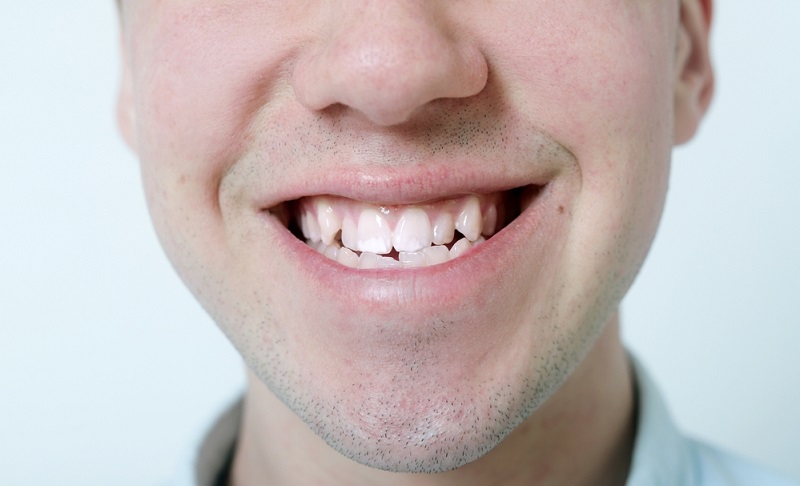How Bite Problems Impact Your Overall Health at the Workplace?
Contents

In today’s professional setting, success often hinges on our ability to communicate effectively, make a positive impression and perform at our best.
One aspect of oral health that often goes untreated is bite problems. Also known as malocclusions, bite problems refer to any misalignment or incorrect positioning of the teeth when the jaws come together.
These issues can affect how the upper and lower teeth fit together when you close your mouth, and they can lead to various dental problems that can impact your demeanour and work quality at the workplace.
Types of Bite Problems
1. Overbite
Overbite Occurs when the front upper teeth overlap significantly with the lower front teeth when the mouth is closed.
This condition can lead to excessive wear on the lower teeth and may cause jaw pain or discomfort.
2. Underbite
Underbite is the opposite of an overbite, where the lower front teeth protrude in front of the upper front teeth.
It can affect speech and eating patterns and may lead to facial asymmetry.
3. Crossbite
Crossbite happens when some upper teeth sit inside the lower teeth when the mouth is closed, while the others sit outside.
This can lead to uneven wear on the teeth and jaw problems.
4. Open bite
Openbite occurs when there is a gap between the upper teeth and lower teeth when the mouth is closed.
This can affect speech and cause difficulty in biting and chewing,
5. Crowding
Crowding occurs when there is not enough space in the jaw for all the teeth to align properly.
It can result in crooked teeth, which can be challenging to clean and maintain.
Impact of Bite Problems
1. Decreased Productivity and Concentration
The constant need to adjust one’s bite or deal with pain can make it challenging to focus on tasks, resulting in diverted focus and reduced efficiency at work.
It can lead to frequent discomfort and distraction, causing a decline in productivity.
2. Communication Challenges
Misaligned teeth/ jaw issues can affect speech clarity, thereby affecting confidence levels.
Individuals with bite problems:
- May struggle to pronounce certain words or feel self-conscious about their appearance,
- Hindering work-related communications- with colleagues, clients and superiors, while giving presentations, talking in a boardroom, discussing new ideas, etc.
3. Emotional and Psychological Effects
Coping with bite problems can take an emotional toll. You may experience increased stress, anxiety or self-esteem issues related to your appearance or oral discomfort.
It might lead to being inattentive to important matters or can even lead to one taking more sick days. These emotional effects can adversely impact job satisfaction.
Treatment Options for Bite Problems
1. Traditional Braces:
For years, traditional braces have been the preferred method of treating malocclusions. Brackets, wires, and elastic bands are employed to gently realign teeth.
Traditional braces have some disadvantages despite their effectiveness, including their prominent appearance and difficulties with dental cleanliness.
2. Clear Aligners - The Superior Alternative:
Due to its many benefits, clear aligners have become extremely popular in recent years.
The teeth are softly guided into the proper position by these transparent, custom-made trays, which fit securely over them.
The following is a discussion of why aligners are the preferred course of action.
Aligners: The Best Treatment Option
While traditional braces have their merits, clear aligners emerge as the superior treatment option for working professionals. Here's why:
1. Ease of wearing Aligners over Traditional Braces:
Oral hygiene: Because aligners are removable, it is simpler to maintain excellent oral hygiene and there is less chance of developing gum disease or tooth decay while undergoing treatment.
Dietary Freedom: Unlike traditional braces, aligners can be taken out for meals, allowing people to eat anything they want without being constrained.
Comfort: Aligners' smooth plastic construction ensures a pleasant fit, doing away with the pain and mouth sores frequently associated with traditional braces.
2. Convenience and Flexibility:
A professional's busy lifestyle is perfectly complimented with clear aligners. Compared to braces, they need fewer dental appointments because the aligners can be replaced at home every two weeks.
This ease enables people to properly manage their therapy while balancing obligations and commitments at work.
3. Aesthetics and Confidence:
In the job, keeping a professional appearance is essential. Professionals can have orthodontic treatment with clear aligners without bringing attention to their teeth.
By subtly enhancing their smile, people can connect with others at work with confidence because conventional braces won't affect how they seem.
Life After Bite Problem Treatment
Once bite problems are successfully treated, professionals can reap several long-term benefits:
1. Continued Professional Success:
Professionals can portray themselves with poise and trustworthiness when they have a healthy, aligned smile, which increases self-confidence.
People who have greater self-assurance are more likely to take advantage of new chances, step up into leadership positions, and succeed in their professional endeavours.
2. Long-term Oral Health:
Taking care of malocclusion lowers the likelihood of dental problems like cavities, gum disease, and jaw abnormalities, which contributes to the maintenance of ideal oral health.
This results in fewer dental visits and lowers the possibility of developing oral health issues that can impair work performance.
This entails taking fewer sick days and giving your job your all while maintaining a positive attitude.
3. Confidence and Improved Performance
A smile that is harmonic has a beneficial psychological effect. After receiving malocclusion treatment, professionals frequently report higher levels of self-worth, general well-being, and a more upbeat attitude toward life.
This increased self-assurance has a good impact on social interactions and personal connections outside of the workplace.
Conclusion
Oral health is a critical component of workplace success. Bite problems, if left untreated, can have a significant impact on your professional life.
Recognizing the signs, addressing these issues, and choosing the right treatment option, such as clear aligners, can transform your workplace experience.
Remember, a healthy smile not only enhances your confidence but also elevates your overall quality of life.


